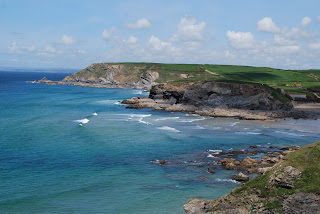So, Cornwall
 I've discovered the New England of England. It's Cornwall. And I say this because after spending a few days here, like New England, I wondered why any English person would live anywhere else in the country. It is simply amazing.
I've discovered the New England of England. It's Cornwall. And I say this because after spending a few days here, like New England, I wondered why any English person would live anywhere else in the country. It is simply amazing.Now, I recognize that I may be influenced by perfect weather an a convertible '71 MG. But I think Cornwall would still be amazing without them. With some 400 miles of coastline, how could it go wrong?
We started out with the unveiling of the MG, which, well into the day of riding around in it, I believed to be a joke. The epitome of coastline viewing transportation. We started by driving through Falmouth and Pendennis, which was only the beginning. We stopped at Gunwalloe where there is a cute little church and, well, beautiful coastline. I worry I'll be saying that too much in this post.
 We headed to the most southerly point in England, the Lizard peninsula. We didn't figure out why it was called Lizard, but who cares? It was not called ugly. There is a very old lighthouse there, an abandoned RNLI station, and tons of natural beauty. We got an enormous pasty (that's pronounced with a long 'a') from the most southern cafe in England and sat on the edge of a cliff enjoying it. Cornwall was a hub of tin mining in the 19th century, and the miners didn't get out of the mines for their lunchbreaks, and therefore were unable to wash the potentially arsenic tinged tin from their hands. Thus, the birth of the pasty, which is basically a thick stew wrapped in pastry. This way, miners could hold one end, eat the rest, and throw the contaminated bit away. Some were even filled half with savory, and half with sweet, though I imagine it did not go well in the middle. I digress.
We headed to the most southerly point in England, the Lizard peninsula. We didn't figure out why it was called Lizard, but who cares? It was not called ugly. There is a very old lighthouse there, an abandoned RNLI station, and tons of natural beauty. We got an enormous pasty (that's pronounced with a long 'a') from the most southern cafe in England and sat on the edge of a cliff enjoying it. Cornwall was a hub of tin mining in the 19th century, and the miners didn't get out of the mines for their lunchbreaks, and therefore were unable to wash the potentially arsenic tinged tin from their hands. Thus, the birth of the pasty, which is basically a thick stew wrapped in pastry. This way, miners could hold one end, eat the rest, and throw the contaminated bit away. Some were even filled half with savory, and half with sweet, though I imagine it did not go well in the middle. I digress. From the Lizard we, um, well I can't remember exactly what we did next, but did visit a very tiny fishing village, Kennick Sands, and Kynance Cove, where the water was freezing, the rocks were huge, and the surf was beautiful. From there to the north coast of Portreath, where we saw seals in the distance and the lighthouse that Virgina Woolf wrote about.
From the Lizard we, um, well I can't remember exactly what we did next, but did visit a very tiny fishing village, Kennick Sands, and Kynance Cove, where the water was freezing, the rocks were huge, and the surf was beautiful. From there to the north coast of Portreath, where we saw seals in the distance and the lighthouse that Virgina Woolf wrote about.All in one day. Wow.
Comments